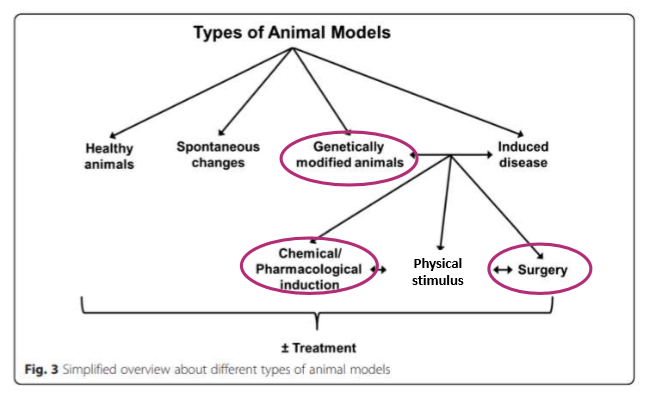Animal Models
1/26
There's no tags or description
Looks like no tags are added yet.
Name | Mastery | Learn | Test | Matching | Spaced |
|---|
No study sessions yet.
27 Terms
what are the 3 aspects of study
levels
models
measures
Molecular level
structure and function of molecular aspects of biological pathways
genes and proteins
uses PCR, gel electrophoresis, blotting and microscopy
most common area of research
Cellular level
investigates structure, function and behaviour of cells
uses cell culture, microscopy and electrophysiology
whole organism level
investigates structure and function of systems using the entire organism
uses behavioural tests and imaging
4 models
In Vivo
Ex vivo
In vitro
In silico
In vitro
within the glass
uses cells from a repository (cell line) - Cell culture
use microscopy and electrophysiology
Ex vivo
Outside the living
cells and tissues from an organism (eg. brain slices)
uses PCR, microscopy and electrophysiology
In vivo
within the living
uses living organisms
uses animal models, microscopy, imaging and electrophysiology
In silico
computational models
simulations based on data collected from other models
two types of measurement
static and functional
static measurements
measurements at a point in time
examine the morphology, density and expression of genes
techniques: microscopy, PCR, gel electrophoresis, blotting, immunohistochemistry and imaging
functional measurements
measurements that are changing over time
activity
techniques: microscopy, electrophysiology, behavioural testing, imaging
define animal models
non-human species used in biomedical research to mimic aspects of a biological process or disease found in humans
anatomy, physiology or response to a pathogen are similar enough to that of a human that their results can be extrapolated to improve human understanding
allow the performing of experiments that would be impractical or ethically prohibited with humans
Naive animal
an animal with no changes made to it, used to understand normal function
animal model
has been idealised or modified to represent something (eg. disease)
reasons to use drosophila, c.elegans and zebra fish
less complex nervous system than mammals (easier to understand but harder to translate to mammals)
cheaper and faster to breed
good for fundamental questions about genetics
highly conserved genetics (homologues)
can do behavioural studies (drosophila in mazes)
reasons to use mice and rats in animal research
mammalian nervous system so more translatable to humans
mice are most common for genetic models
rats are best when size or easy training is important
cheaper and faster than large animals
reasons to use larger animals in animal research
brain structure needs to be more similar to humans
sheep have folded cortex and solid tentorium (dura mater) —> good for stroke research
UK legislation on selecting animals for research
must use lowest sentient being to address the question
what are the three criteria for animal models?
predictive validity
face validity
constructive validity
Predictive validity
behaviour
do outcome measures from the animal correlate with the condition
face validity
neurobiology
does the animal model correspond ecologically, biochemically and pathologically to the condition?
constructive validity
mechanisms
does the model hold up the theoretical rational regarding mechanisms?
types of animal models

different ways to genetically modify animals
knock in
knock out
altering DNA to express characteristics
how might surgery be used on animal models?
causing lesions
causing pain